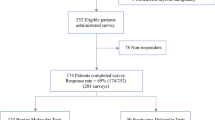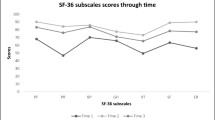Abstract
Purpose
To present the impact of treatment on health-related quality-of-life (HRQOL) and health utility measures from the randomized controlled trial (ClinicalTrials.gov Identifier: NCT02398721) that investigated the FNAC versus watchful surveillance in patients with incidental benign thyroid nodules.
Methods
Health utility and HRQOL were evaluated using the EQ-5D 5-level (EQ-5D-5L), 6-item Short-Form Health Survey (SF-6D), and generic 12-item Short-Form Health Survey (SF-12v2) at baseline, 3-month, 6-month, and 12-month assessments. A repeated measure analysis of variance evaluated differences in HRQOL scores between treatment groups over time. Multiple imputations were used to impute missing data at each time point.
Results
HRQOL data completion rates were 99.7% at baseline, 92.7% at 3-month, 93.9% at 6-month, 92.7% at 12-month, and 88.6% at 18-month follow-up after baseline. There were significant mean differences in SF-6D, EQ-5D-5L, and SF-12v2 over time except the domain of vitality and mental health of SF-12v2. Mean change of SF-12v2 scores and utility scores from baseline between groups did not exceed minimal important difference. No significant treatment group by time interactions were found in all HRQOL and utility scores except in the vitality domain and PCS of SF-12v2 (p value = 0.033; 0.024).
Conclusions
When compared with watchful surveillance, FNAC intervention was associated with better vitality and physical-related HRQOL scores but did not provide better preservation of utility score improvement over the 18-month period. These findings support the routine FNAC approach for nodules that have a low-suspicion sonographic pattern and measure between 1.0 and 2.0 cm.

Similar content being viewed by others
References
S. Ezzat et al. Thyroid incidentalomas: prevalence by palpation and ultrasonography. Arch. Intern. Med. 154(16), 1838–1840 (1994)
D.S. Dean, H. Gharib, Epidemiology of thyroid nodules. Best. Pract. Res. Clin. Endocrinol. Metab. 22(6), 901–911 (2008)
D.S. Ross, Nonpalpable thyroid nodules–managing an epidemic. J. Clin. Endocrinol. Metab. 87(5), 1938–1940 (2002)
G. Russ, Risk stratification of thyroid nodules on ultrasonography with the French TI-RADS: description and reflections. Ultrasonography 35(1), 25–38 (2016)
S. Leboulleux et al. Frequency and intensity of pain related to thyroid nodule fine-needle aspiration cytology. Thyroid 23(9), 1113–1118 (2013)
B.R. Haugen et al. 2015 American thyroid association management guidelines for adult patients with thyroid nodules and differentiated thyroid cancer: the American thyroid association guidelines task force on thyroid nodules and differentiated thyroid cancer. Thyroid 26(1), 1–133 (2016)
L. Lodewijk et al. Same-day fine-needle aspiration cytology diagnosis for thyroid nodules achieves rapid anxiety decrease and high diagnostic accuracy. Endocr. Pract. 22(5), 561–566 (2016)
C.K.H. Wong et al. EQ-5D-5L and SF-6D utility measures in symptomatic benign thyroid nodules: acceptability and psychometric evaluation. Patient 10(4), 447–454 (2017)
P. Wang et al. The EQ-5D-5L is more discriminative than the EQ-5D-3L in patients with diabetes in Singapore. Value Health Reg. Issues 9, 57–62 (2016)
P.W.H. Cheung et al. Psychometric validation of the EuroQoL 5-Dimension 5-Level (EQ-5D-5L) in Chinese patients with adolescent idiopathic scoliosis. Scoliosis Spinal Disord. 11, 19 (2016)
C.-W. Pan et al. Valuing health-related quality of life in type 2 diabetes patients in China. Med. Decis. Mak. 36(2), 234–241 (2016)
B. van Hout et al. Interim scoring for the EQ-5D-5L: mapping the EQ-5D-5L to EQ-5D-3L value sets. Value Health 15(5), 708–715 (2012)
G.G. Liu et al. Chinese time trade-off values for EQ-5D health states. Value Health 17(5), 597–604 (2014)
N.S. McClure et al. Instrument-defined estimates of the minimally important difference for EQ-5D-5L index scores. Value Health 20(4), 644–650 (2017)
J.E. Brazier, J. Roberts, The estimation of a preference-based measure of health from the SF-12. Med. Care 42(9), 851–859 (2004)
C.L.K. Lam, J. Brazier, S.M. McGhee, Valuation of the SF-6D health states is feasible, acceptable, reliable, and valid in a chinese population. Value Health 11(2), 295–303 (2008)
S.M. McGhee et al. Quality-adjusted life years: population-specific measurement of the quality component. Hong. Kong Med. J. 17(Suppl 6), 17–21 (2011)
S.J. Walters, J.E. Brazier, Comparison of the minimally important difference for two health state utility measures: EQ-5D and SF-6D. Qual. Life Res. 14(6), 1523–1532 (2005)
C.K. Wong, E.T. Lam, C.L. Lam, Comparison of direct-measured and derived short form six dimensions (SF-6D) health preference values among chronic hepatitis B patients. Qual. Life Res. 22(10), 2973–2981 (2013)
Acknowledgements
The research team would like to express our greatest gratitude to Ms. LI Wing Kar and Mr. YU Ming-Sing for coordinating data collection and conducting data analysis. Special thanks to Ms. LIU Xiaodong for the support.
Funding
This study has been funded by the Health and Medical Research Fund, Food and Health Bureau, HKSAR (Ref. no 12132941). The funders had no role in study design, data collection and analysis, decision to publish, or preparation of the manuscript.
Author information
Authors and Affiliations
Corresponding author
Ethics declarations
Conflict of interest
The authors declare that they have no conflict of interest.
Informed consent
Informed consent was obtained from all individual participants included in the study.
Additional information
Publisher’s note Springer Nature remains neutral with regard to jurisdictional claims in published maps and institutional affiliations.
Supplementary information
Rights and permissions
About this article
Cite this article
Wong, C.K.H., Lang, B.H.H. A randomized trial comparing health-related quality-of-life and utility measures between routine fine-needle aspiration cytology (FNAC) and surveillance alone in patients with thyroid incidentaloma measuring 1–2 cm. Endocrine 67, 397–405 (2020). https://doi.org/10.1007/s12020-019-02129-y
Received:
Accepted:
Published:
Issue Date:
DOI: https://doi.org/10.1007/s12020-019-02129-y




